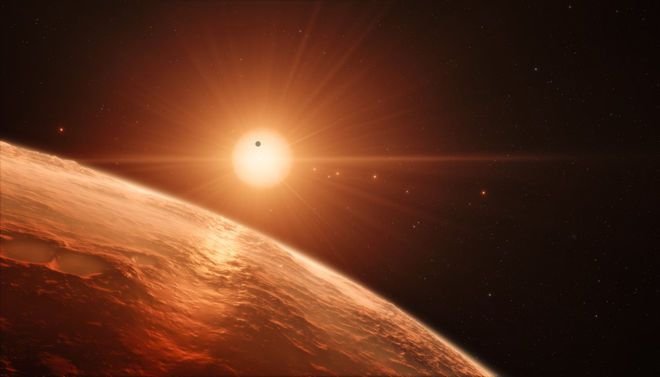NASA broke news about a major new discovery. They discovered a star with seven earth-like exoplanets orbiting around it. The star’s official name is 2MASS J23062928-0502285, but the unofficial name is Trappist-1. Trappist-1 is a cool Red Dwarf star in the Aquarius constellation. Calling the star cool does not mean that it is actually cool. It just means this star burns at a much cooler temperature than our sun. Trappist-1 is located about 39.5 light years from our solar system, or roughly around 231.6 Trillion miles away.
To put that into perspective, the distance from Earth to the Sun is around 93 million miles. Trappist-1 is about 2.5 million times the distance between Earth and the sun. To put it into perspective even further. The top speed of the Space Shuttle is around 17,500 Miles Per Hour, or Mach 22. If the space shuttle were to travel at top speed the entire way to the Trappist-1 system, it would take roughly 1.5 million years to reach the system.
What is so ground breaking about this discovery is that the data shows there are three potentially Earth-like and Earth-sized planets within the habitable zone of this Red Dwarf Star. According to Michael Gillon, the principal investigator of the TRAPPIST exoplanet survey at the University of Liege, Belgium was quoted as saying, “The seven wonders of TRAPPIST-1 are the first Earth-size planets that have been found orbiting this kind of star.”
What makes this a big deal is that three of these planets (Trappist 1d, 1e, 1f) are estimated to be around the same size of Earth and have a solid Rocky surface, similar to Earth, and could contain liquid water and an atmosphere capable of sustaining life. NASA also talks about the potential of the seventh planet to be a frozen ice world, which could be very similar to the ice planet from the Hollywood Blockbuster Film Interstellar.
The Star itself, as described above is an ultra-cool Red Dwarf star. The temperature of the surface of the sun is roughly around 9,940 degrees Fahrenheit, while the temperature of Trappist-1 is roughly around 4,130 degrees Fahrenheit, or less than half the temperature of the surface of the sun. This lower temperature would allow for planets to contain liquid water much closer to Trappist-1(around 20 to 100 times closer than our planets are to our sun). To put that into perspective, if Trappist-1 were our sun, we could be any where from an estimated 1 million to 4.7 million miles away from the star and still maintain the same climate we do now, being 93 million miles from our current sun.
In regards to size, the sun measures 864,938 miles in diameter, with a circumference of around 2.7 million miles. You could fit 1.3 million Earths inside the Sun. Trappist-1 however, is much smaller. Trappist-1 measures slightly larger than the planet Jupiter or around eight percent the size of our Sun. This equates to a diameter of around 87,000 miles, and a circumference of 273,180 miles. With this being said, you could still fit around 1,300 Earths inside Trappist-1.
This exciting new discovery opens up many new possibilities for habitable planets outside our solar system. While seeing this planetary system in our lifetime looks to be completely out of the question, that doesn’t stop scientists from trying to learn everything they can about the Trappist-1 system.
Do any of these planets contain liquid water? Can they support life as we know it? Those are both questions that beg to be answered. The thought of exploring planets outside of our galaxy is both thought provoking and exciting. We as humans are explorers by nature. The desire to explore the galaxy and venture into the unknown is in our DNA.
Hopefully one day, mankind will venture out of our solar system and as they say in Star Trek, explore strange new worlds, seek out new life and new civilizations, and to go where no one has gone before.
Great article!
Hi! I am a robot. I just upvoted you! I found similar content that readers might be interested in:
https://ahill8003.wordpress.com/2017/02/27/trappist-1-the-future-home-of-mankind/
Hi! That link is from my personal blog.
Congratulations @ahill8003! You have received a personal award!
Click on the badge to view your Board of Honor.
Do not miss the last post from @steemitboard!
Participate in the SteemitBoard World Cup Contest!
Collect World Cup badges and win free SBD
Support the Gold Sponsors of the contest: @good-karma and @lukestokes
Congratulations @ahill8003! You received a personal award!
You can view your badges on your Steem Board and compare to others on the Steem Ranking
Vote for @Steemitboard as a witness to get one more award and increased upvotes!